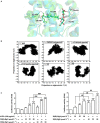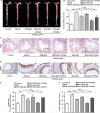Ginsenoside Rg3 stereoisomers differentially inhibit vascular smooth muscle cell proliferation and migration in diabetic atherosclerosis
- PMID: 29566305
- PMCID: PMC5980205
- DOI: 10.1111/jcmm.13601
Ginsenoside Rg3 stereoisomers differentially inhibit vascular smooth muscle cell proliferation and migration in diabetic atherosclerosis
Abstract
Ginsenoside 20(R/S)-Rg3, as a natural peroxisome proliferator-activated receptor gamma (PPARγ) ligand, has been reported to exhibit differential biological effects. It is of great interest to understand the stereochemical selectivity of 20(R/S)-Rg3 and explore whether differential PPARγ activation by Rg3 stereoisomers, if it exists, could lead to differential physiological outcome and therapeutic effects in diabetic atherosclerosis. Here, we investigated the binding modes of 20(R/S)-Rg3 stereoisomers in the PPARγ ligand-binding domain (PPARγ-LBD) using molecular modelling and their effects on smooth muscle cell proliferation and migration induced by advanced glycation end products (AGEs). The results revealed that 20(S)-Rg3 exhibited stronger antiproliferative and antimigratory effects due to stronger PPARγ activation. To validate the in vitro results, we used a mice model with diabetic atherosclerosis and obtained that 20(S)-Rg3 markedly reduced the plaque size secondary to reducing the proliferation and migration of VSMCs, while the plaques were more stable due to improvements in other plaque compositions. The results shed light on the structural difference between Rg3 stereoisomers that can lead to significant differential physiological outcome, and the (S)-isomer seems to be the more potent isomer to be developed as a promising drug for diabetic atherosclerosis.
Keywords: PPARγ; Rg3; atherosclerosis; ginsenoside; stereoisomer.
© 2018 The Authors. Journal of Cellular and Molecular Medicine published by John Wiley & Sons Ltd and Foundation for Cellular and Molecular Medicine.
Figures







Similar articles
-
Stereoisomers ginsenosides-20(S)-Rg₃ and -20(R)-Rg₃ differentially induce angiogenesis through peroxisome proliferator-activated receptor-gamma.Biochem Pharmacol. 2012 Apr 1;83(7):893-902. doi: 10.1016/j.bcp.2011.12.039. Epub 2012 Jan 4. Biochem Pharmacol. 2012. PMID: 22234331
-
Ginsenoside Rg3 Mitigates Atherosclerosis Progression in Diabetic apoE-/- Mice by Skewing Macrophages to the M2 Phenotype.Front Pharmacol. 2018 May 9;9:464. doi: 10.3389/fphar.2018.00464. eCollection 2018. Front Pharmacol. 2018. PMID: 29867472 Free PMC article.
-
Differential expression of PPARγ by pioglitazone and telmisartan causes effect of disparity on mTORC2-mediated cell proliferation and migration.Sci Rep. 2025 Jul 1;15(1):22112. doi: 10.1038/s41598-025-93320-x. Sci Rep. 2025. PMID: 40594875 Free PMC article.
-
Peroxisome proliferator-activated receptor-gamma-mediated effects in the vasculature.Circ Res. 2008 Feb 15;102(3):283-94. doi: 10.1161/CIRCRESAHA.107.164384. Circ Res. 2008. PMID: 18276926 Review.
-
New possible pharmacological targets for statins and ezetimibe.Biomed Pharmacother. 2020 Sep;129:110388. doi: 10.1016/j.biopha.2020.110388. Epub 2020 Jun 16. Biomed Pharmacother. 2020. PMID: 32559626 Review.
Cited by
-
Functional compounds of ginseng and ginseng-containing medicine for treating cardiovascular diseases.Front Pharmacol. 2022 Dec 2;13:1034870. doi: 10.3389/fphar.2022.1034870. eCollection 2022. Front Pharmacol. 2022. PMID: 36532771 Free PMC article. Review.
-
Long noncoding RNA LINC00341 promotes the vascular smooth muscle cells proliferation and migration via miR-214/FOXO4 feedback loop.Am J Transl Res. 2019 Mar 15;11(3):1835-1842. eCollection 2019. Am J Transl Res. 2019. PMID: 30972207 Free PMC article.
-
Natural products in atherosclerosis therapy by targeting PPARs: a review focusing on lipid metabolism and inflammation.Front Cardiovasc Med. 2024 Apr 18;11:1372055. doi: 10.3389/fcvm.2024.1372055. eCollection 2024. Front Cardiovasc Med. 2024. PMID: 38699583 Free PMC article. Review.
-
Advanced Glycation End Products Induce Proliferation and Migration of Human Aortic Smooth Muscle Cells through PI3K/AKT Pathway.Biomed Res Int. 2020 Jul 13;2020:8607418. doi: 10.1155/2020/8607418. eCollection 2020. Biomed Res Int. 2020. PMID: 32733959 Free PMC article.
-
Ginsenoside Rh1 Inhibits Angiotensin II-Induced Vascular Smooth Muscle Cell Migration and Proliferation through Suppression of the ROS-Mediated ERK1/2/p90RSK/KLF4 Signaling Pathway.Antioxidants (Basel). 2022 Mar 27;11(4):643. doi: 10.3390/antiox11040643. Antioxidants (Basel). 2022. PMID: 35453328 Free PMC article.
References
-
- Karmazyn M, Moey M, Gan XT. Therapeutic potential of ginseng in the management of cardiovascular disorders. Drugs. 2011;71:1989‐2008. - PubMed
-
- Shishtar E, Jovanovski E, Jenkins Aet al. Effects of Korean White Ginseng (Panax Ginseng C.A. Meyer) on Vascular and Glycemic Health in Type 2 Diabetes: results of a Randomized, Double Blind, Placebo‐controlled, Multiple‐crossover, Acute Dose Escalation Trial. Clin. Nutr Res. 2014;3:89‐97. - PMC - PubMed
-
- Shibata S, Fujita M, Itokawa H, Tanaka O, Ishii T. Studies on the Constituents of Japanese and Chinese Crude Drugs. Xi. Panaxadiol, a Sapogenin of Ginseng Roots. Chem Pharm Bull (Tokyo). 1963;11:759‐761. - PubMed
-
- Jeong SM, Lee JH, Kim JH, et al. Stereospecificity of ginsenoside Rg3 action on ion channels. Mol Cells. 2004;18:383‐389. - PubMed
-
- Kim JH, Lee JH, Jeong SM, et al. Stereospecific effects of ginsenoside Rg3 epimers on swine coronary artery contractions. Biol Pharm Bull. 2006;29:365‐370. - PubMed
Publication types
MeSH terms
Substances
LinkOut - more resources
Full Text Sources
Other Literature Sources
Medical

